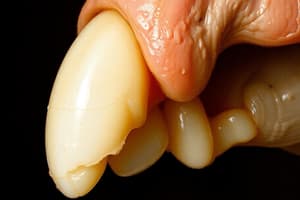Podcast
Questions and Answers
What is the average age at which ameloblastic fibroma is commonly diagnosed?
What is the average age at which ameloblastic fibroma is commonly diagnosed?
- 20 years
- 5 years
- 10 years
- 14 years (correct)
Where is ameloblastic fibroma most commonly found?
Where is ameloblastic fibroma most commonly found?
- Mandibular molar area (correct)
- Maxillary anterior region
- Maxillary posterior region
- Mandibular anterior region
Which feature is characteristic of the histopathological structure of ameloblastic fibroma?
Which feature is characteristic of the histopathological structure of ameloblastic fibroma?
- Thin strands and cords of odontogenic epithelium (correct)
- Dense collagenized connective tissue
- Presence of numerous necrotic cells
- Granulation tissue with inflammatory cells
How does ameloblastic fibroma typically present radiographically?
How does ameloblastic fibroma typically present radiographically?
What type of cellular composition is found in the connective tissue background of ameloblastic fibroma?
What type of cellular composition is found in the connective tissue background of ameloblastic fibroma?
Flashcards
Ameloblastic Fibroma
Ameloblastic Fibroma
A benign tumor of the jaw that contains both developing tooth enamel-like cells (ameloblasts) and fibrous tissue.
Age of ameloblastic fibroma
Age of ameloblastic fibroma
The average age at which ameloblastic fibroma is diagnosed.
Common location of ameloblastic fibroma
Common location of ameloblastic fibroma
The most frequent location of ameloblastic fibroma in the jaw.
Radiographic appearance of ameloblastic fibroma
Radiographic appearance of ameloblastic fibroma
Signup and view all the flashcards
Histological resemblance in ameloblastic fibroma
Histological resemblance in ameloblastic fibroma
Signup and view all the flashcards
Study Notes
Ameloblastic Fibroma: A benign mixed odontogenic neoplasm, known as ameloblastic fibroma, arises from the odontogenic epithelium, which is a crucial component in the development of teeth, and occurs in an environment characterized by rapidly dividing connective tissue. This neoplasm most commonly presents in adolescents around the age of 14 and is typically found in the mandibular molar region, a common site due to the complex dental structure in that area. Although it is generally painless, the lesion exhibits slow growth, which can result in slight bone expansion that is often observed in dental evaluations. Radiographically, ameloblastic fibromas are identifiable as unilocular or multilocular radiolucent areas, indicating a less dense structure compared to surrounding bone. Histological examination reveals thin strands of odontogenic epithelium interspersed with embryonic fibroblastic connective tissue, which may show signs of hyalinization, indicating a level of tissue maturation and alteration.
Studying That Suits You
Use AI to generate personalized quizzes and flashcards to suit your learning preferences.
Description
This quiz explores the characteristics and implications of ameloblastic fibroma, a benign mixed odontogenic neoplasm commonly found in adolescents. It highlights the histological features, radiographic appearance, and typical location of this unique dental condition. Ideal for dental students and professionals seeking to deepen their understanding of oral pathology.




